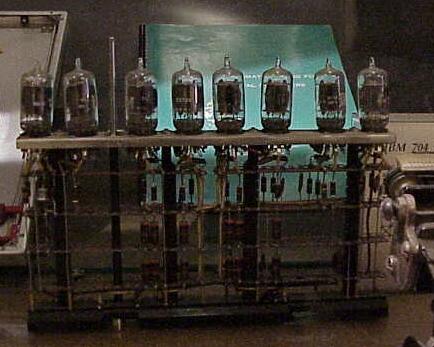 | Floor 2 |
 |
 |

|
 |
 |
One of about 4000 Logic Modules for an IBM 704 Computer (1954).
The IBM 704 became the dominant vaccuum-tube logic computer in the
late 1950'ies. A 32K, 36-bit word memory was the largest available, but
because of the cost of memory 8K and 16K systems were common.
It was the first IBM machine to use
core memory.
The memory cycle time was 12 microsecs and an
integer addition in its registers of 36 bits required two cycles, one
for the instruction fetch and on for the data fetch.
Floating point operations required on the order of 10 such cycles.
Each 36-bit computer instruction contained 1 or 2 address fields of 15 bits,
so that the full 32K, 36-bit word memory could be addressed directly.
The two fields were called decrement (an index) and
address, and those names live on in the LISP commands CDR amd
CAR.
Some notes about early computers can be found in George Sadowsky's Retirement Lecture.
A 1960 successor, the IBM 709 introduced distinct input-output channels, that allowed input output to proceed in paralleel with computation. At government request IBM built a transistorized version, first designated to be the 709T. This machine, renumbered 7090, became the prime IBM scientific computer until the 360-series arrived in 1966. An IBM 7094 (enhanced with 7 instead of 3 index registers) became a prime computing machine at Stanford and is shown, with Prof. McCarthy using a chess program on it, on the main floor.
 | Floor 2 |
 |
 |

|
 |